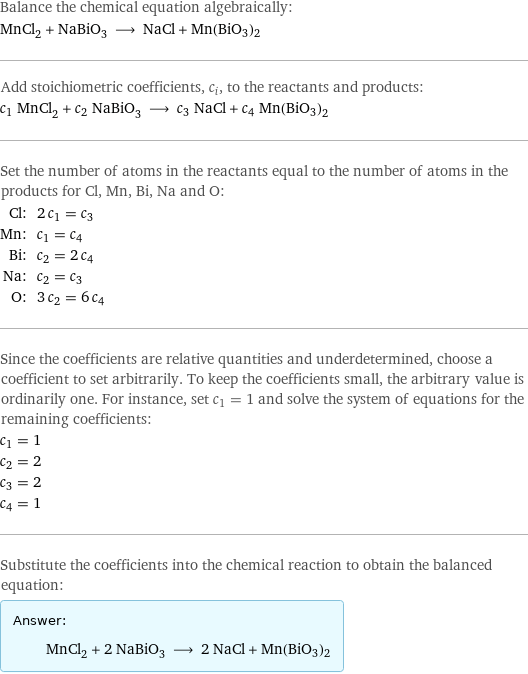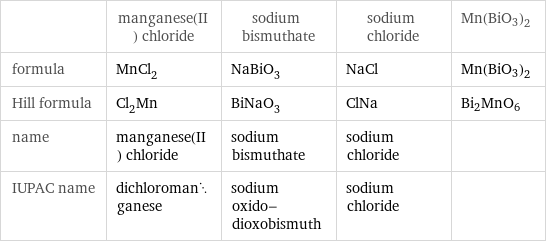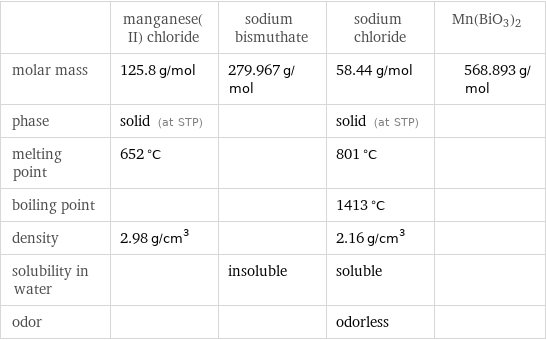Input interpretation

MnCl_2 manganese(II) chloride + NaBiO_3 sodium bismuthate ⟶ NaCl sodium chloride + Mn(BiO3)2
Balanced equation

Balance the chemical equation algebraically: MnCl_2 + NaBiO_3 ⟶ NaCl + Mn(BiO3)2 Add stoichiometric coefficients, c_i, to the reactants and products: c_1 MnCl_2 + c_2 NaBiO_3 ⟶ c_3 NaCl + c_4 Mn(BiO3)2 Set the number of atoms in the reactants equal to the number of atoms in the products for Cl, Mn, Bi, Na and O: Cl: | 2 c_1 = c_3 Mn: | c_1 = c_4 Bi: | c_2 = 2 c_4 Na: | c_2 = c_3 O: | 3 c_2 = 6 c_4 Since the coefficients are relative quantities and underdetermined, choose a coefficient to set arbitrarily. To keep the coefficients small, the arbitrary value is ordinarily one. For instance, set c_1 = 1 and solve the system of equations for the remaining coefficients: c_1 = 1 c_2 = 2 c_3 = 2 c_4 = 1 Substitute the coefficients into the chemical reaction to obtain the balanced equation: Answer: | | MnCl_2 + 2 NaBiO_3 ⟶ 2 NaCl + Mn(BiO3)2
Structures

+ ⟶ + Mn(BiO3)2
Names

manganese(II) chloride + sodium bismuthate ⟶ sodium chloride + Mn(BiO3)2
Equilibrium constant
![Construct the equilibrium constant, K, expression for: MnCl_2 + NaBiO_3 ⟶ NaCl + Mn(BiO3)2 Plan: • Balance the chemical equation. • Determine the stoichiometric numbers. • Assemble the activity expression for each chemical species. • Use the activity expressions to build the equilibrium constant expression. Write the balanced chemical equation: MnCl_2 + 2 NaBiO_3 ⟶ 2 NaCl + Mn(BiO3)2 Assign stoichiometric numbers, ν_i, using the stoichiometric coefficients, c_i, from the balanced chemical equation in the following manner: ν_i = -c_i for reactants and ν_i = c_i for products: chemical species | c_i | ν_i MnCl_2 | 1 | -1 NaBiO_3 | 2 | -2 NaCl | 2 | 2 Mn(BiO3)2 | 1 | 1 Assemble the activity expressions accounting for the state of matter and ν_i: chemical species | c_i | ν_i | activity expression MnCl_2 | 1 | -1 | ([MnCl2])^(-1) NaBiO_3 | 2 | -2 | ([NaBiO3])^(-2) NaCl | 2 | 2 | ([NaCl])^2 Mn(BiO3)2 | 1 | 1 | [Mn(BiO3)2] The equilibrium constant symbol in the concentration basis is: K_c Mulitply the activity expressions to arrive at the K_c expression: Answer: | | K_c = ([MnCl2])^(-1) ([NaBiO3])^(-2) ([NaCl])^2 [Mn(BiO3)2] = (([NaCl])^2 [Mn(BiO3)2])/([MnCl2] ([NaBiO3])^2)](../image_source/b7fcf6cfa7594b40c013dedfce6965d0.png)
Construct the equilibrium constant, K, expression for: MnCl_2 + NaBiO_3 ⟶ NaCl + Mn(BiO3)2 Plan: • Balance the chemical equation. • Determine the stoichiometric numbers. • Assemble the activity expression for each chemical species. • Use the activity expressions to build the equilibrium constant expression. Write the balanced chemical equation: MnCl_2 + 2 NaBiO_3 ⟶ 2 NaCl + Mn(BiO3)2 Assign stoichiometric numbers, ν_i, using the stoichiometric coefficients, c_i, from the balanced chemical equation in the following manner: ν_i = -c_i for reactants and ν_i = c_i for products: chemical species | c_i | ν_i MnCl_2 | 1 | -1 NaBiO_3 | 2 | -2 NaCl | 2 | 2 Mn(BiO3)2 | 1 | 1 Assemble the activity expressions accounting for the state of matter and ν_i: chemical species | c_i | ν_i | activity expression MnCl_2 | 1 | -1 | ([MnCl2])^(-1) NaBiO_3 | 2 | -2 | ([NaBiO3])^(-2) NaCl | 2 | 2 | ([NaCl])^2 Mn(BiO3)2 | 1 | 1 | [Mn(BiO3)2] The equilibrium constant symbol in the concentration basis is: K_c Mulitply the activity expressions to arrive at the K_c expression: Answer: | | K_c = ([MnCl2])^(-1) ([NaBiO3])^(-2) ([NaCl])^2 [Mn(BiO3)2] = (([NaCl])^2 [Mn(BiO3)2])/([MnCl2] ([NaBiO3])^2)
Rate of reaction
![Construct the rate of reaction expression for: MnCl_2 + NaBiO_3 ⟶ NaCl + Mn(BiO3)2 Plan: • Balance the chemical equation. • Determine the stoichiometric numbers. • Assemble the rate term for each chemical species. • Write the rate of reaction expression. Write the balanced chemical equation: MnCl_2 + 2 NaBiO_3 ⟶ 2 NaCl + Mn(BiO3)2 Assign stoichiometric numbers, ν_i, using the stoichiometric coefficients, c_i, from the balanced chemical equation in the following manner: ν_i = -c_i for reactants and ν_i = c_i for products: chemical species | c_i | ν_i MnCl_2 | 1 | -1 NaBiO_3 | 2 | -2 NaCl | 2 | 2 Mn(BiO3)2 | 1 | 1 The rate term for each chemical species, B_i, is 1/ν_i(Δ[B_i])/(Δt) where [B_i] is the amount concentration and t is time: chemical species | c_i | ν_i | rate term MnCl_2 | 1 | -1 | -(Δ[MnCl2])/(Δt) NaBiO_3 | 2 | -2 | -1/2 (Δ[NaBiO3])/(Δt) NaCl | 2 | 2 | 1/2 (Δ[NaCl])/(Δt) Mn(BiO3)2 | 1 | 1 | (Δ[Mn(BiO3)2])/(Δt) (for infinitesimal rate of change, replace Δ with d) Set the rate terms equal to each other to arrive at the rate expression: Answer: | | rate = -(Δ[MnCl2])/(Δt) = -1/2 (Δ[NaBiO3])/(Δt) = 1/2 (Δ[NaCl])/(Δt) = (Δ[Mn(BiO3)2])/(Δt) (assuming constant volume and no accumulation of intermediates or side products)](../image_source/f342f72dc46056772915abd77a888de0.png)
Construct the rate of reaction expression for: MnCl_2 + NaBiO_3 ⟶ NaCl + Mn(BiO3)2 Plan: • Balance the chemical equation. • Determine the stoichiometric numbers. • Assemble the rate term for each chemical species. • Write the rate of reaction expression. Write the balanced chemical equation: MnCl_2 + 2 NaBiO_3 ⟶ 2 NaCl + Mn(BiO3)2 Assign stoichiometric numbers, ν_i, using the stoichiometric coefficients, c_i, from the balanced chemical equation in the following manner: ν_i = -c_i for reactants and ν_i = c_i for products: chemical species | c_i | ν_i MnCl_2 | 1 | -1 NaBiO_3 | 2 | -2 NaCl | 2 | 2 Mn(BiO3)2 | 1 | 1 The rate term for each chemical species, B_i, is 1/ν_i(Δ[B_i])/(Δt) where [B_i] is the amount concentration and t is time: chemical species | c_i | ν_i | rate term MnCl_2 | 1 | -1 | -(Δ[MnCl2])/(Δt) NaBiO_3 | 2 | -2 | -1/2 (Δ[NaBiO3])/(Δt) NaCl | 2 | 2 | 1/2 (Δ[NaCl])/(Δt) Mn(BiO3)2 | 1 | 1 | (Δ[Mn(BiO3)2])/(Δt) (for infinitesimal rate of change, replace Δ with d) Set the rate terms equal to each other to arrive at the rate expression: Answer: | | rate = -(Δ[MnCl2])/(Δt) = -1/2 (Δ[NaBiO3])/(Δt) = 1/2 (Δ[NaCl])/(Δt) = (Δ[Mn(BiO3)2])/(Δt) (assuming constant volume and no accumulation of intermediates or side products)
Chemical names and formulas

| manganese(II) chloride | sodium bismuthate | sodium chloride | Mn(BiO3)2 formula | MnCl_2 | NaBiO_3 | NaCl | Mn(BiO3)2 Hill formula | Cl_2Mn | BiNaO_3 | ClNa | Bi2MnO6 name | manganese(II) chloride | sodium bismuthate | sodium chloride | IUPAC name | dichloromanganese | sodium oxido-dioxobismuth | sodium chloride |
Substance properties

| manganese(II) chloride | sodium bismuthate | sodium chloride | Mn(BiO3)2 molar mass | 125.8 g/mol | 279.967 g/mol | 58.44 g/mol | 568.893 g/mol phase | solid (at STP) | | solid (at STP) | melting point | 652 °C | | 801 °C | boiling point | | | 1413 °C | density | 2.98 g/cm^3 | | 2.16 g/cm^3 | solubility in water | | insoluble | soluble | odor | | | odorless |
Units
